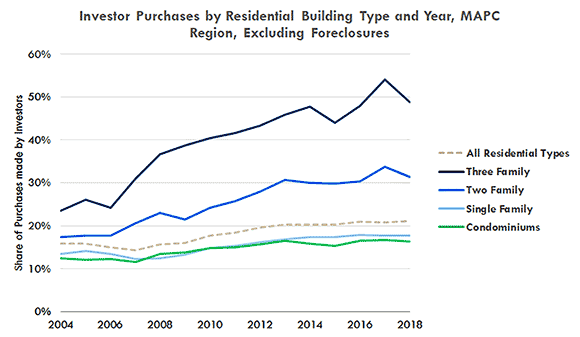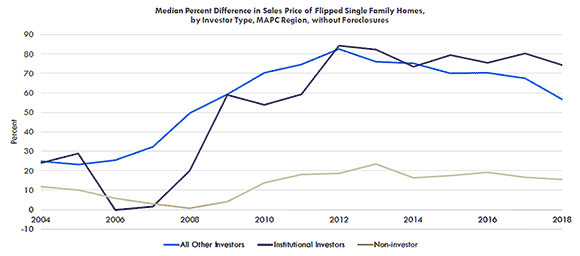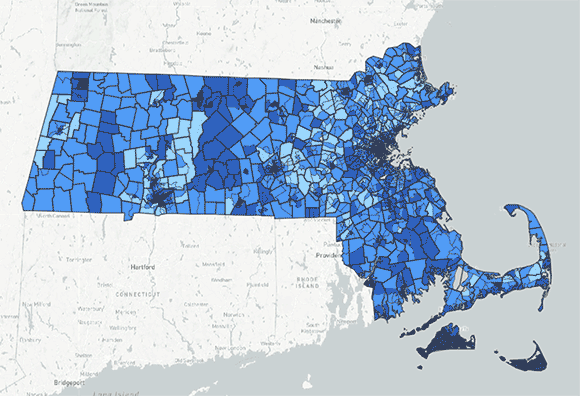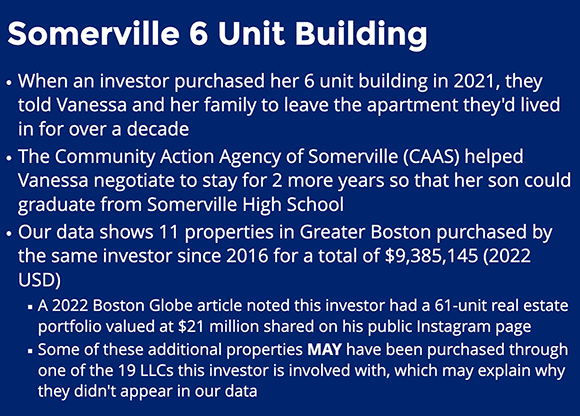(The opinions and views expressed in the commentaries and letters to the Editor of The Somerville Times belong solely to the authors and do not reflect the views or opinions of The Somerville Times, its staff or publishers)

By State Senator Pat Jehlen
There’s a strong consensus that we need hundreds of thousands of new housing units in Massachusetts. Governor Healey said in her State of the Commonwealth address that housing is our greatest challenge.
The Metropolitan Area Planning Council’s recent report, Homes for Profit: Speculation and Investment in Greater Boston, uncovered another problem that prevents potential homebuyers from competing in the market, and raises rents for tenants.
A large and increasing share of homes are sold to large investors
Individual families are out-bid by investors, who can pay cash with no conditions.
These investor-buyers then raise rents up to 70%, effectively evicting long-term renters, or simply evict them with no cause.
Across the metropolitan area, the report found that investor purchases increased from 16% of housing sales in 2004 to 23% in 2018.
Three-family homes are commonly purchased by investors

Though the report goes through 2022, this chart stops in 2018 for reasons related to methodology.
One of my previous newsletters focused on the importance of 3-deckers for potential homebuyers, and the decline in home ownership in Somerville.
I wrote, “When I moved to Somerville, 3-deckers were the way many working families were able to buy their homes, with multiple generations in the apartments or tenants helping pay off the mortgage. Now, when 3-deckers and even condos are sold, they are fast increasing as a way for investors and corporations to make profits, rather than a chance for homeownership.” The report finds more evidence for this across Greater Boston, especially in Gateway Cities.
At least in our district, three-deckers are being converted to the ubiquitous luxury condos, removing relatively affordable rental units. Tenants are priced out or evicted, and the new condos are not within the budget of working families.
Flipping raises prices

Between eight and ten percent of residential buildings bought between 2014 and 2020 were flipped, i.e., sold within 2 years.
Large apartment buildings and 3-family homes are the most likely to be flipped, and the largest investors are the most likely to flip. When properties are flipped, the sales price increase for large investors is over 70%. The property may have been renovated, but it has become far less affordable for buyers or renters.
Neighborhood by Neighborhood Impact

This map in the report allows you to look at different kinds of investor activity by census tract, by municipality, and for the state. It is really fascinating. For example, here’s a summary for our district.

Even within communities, neighborhoods are very different. For example, in census tract 25017351500 (East Somerville), over half the 3-deckers and almost 2/3 of 2-families were sold to investors, although other statistics for the neighborhood don’t show investor activity that different from the rest of the city. East Somerville has lower income, higher poverty, and lower housing prices than the rest of Somerville.
The report finds that, in general, in neighborhoods like East Somerville (high-density, lower-priced, high shares of renters and immigrants), there are high rates of investor purchases, of foreclosures and cash sales, and rapid price escalation. (To help locate census tracts, look here)
On the other hand, in Winchester, there are few multi-family homes, and zero three-family buildings were sold.
One example of Investor Purchase
In this case, the self-described young “small property owner” ended up allowing a mother to stay two years so her son could graduate from Somerville High, thanks to tenant organizing by CAAS.

What do you see in your neighborhood?
Do you see examples of neighborhood change due to investor activity? Tell me what you’ve noticed. Or explore the maps and make observations about different neighborhoods.
And tell me if you think you can recognize houses that have been, or are being renovated, by investors.
“You can’t build old and cheap”
At a recent meeting about Somerville zoning and the Somernova proposal, one resident made this insightful comment. The cheapest, fastest, and most environmentally friendly way to reduce housing costs is to remove existing homes from the speculative market. Of course, we need a lot more housing, but we also need tools to protect naturally-occurring relatively-affordable homes.
Who buys ugly houses?
I’ve always wondered about these signs saying “We Buy Ugly Houses.” (This sign is near Porter Square.). Here’s the Ugly Houses Boston website, which says they are America’s #1 home buyer. I don’t know who the local franchise owners are, and they get generally favorable reviews. But this ProPublica report, “The Ugly Truth Behind ‘We Buy Ugly Houses,” suggests “caveat venditor;” [seller beware]. The article says the company, HomeVestors, targets, misleads, and pressures vulnerable people, often older people or those in financial difficulty, to sell their homes quickly for far below market value.
Policy recommendations
MAPC recommends policies such as:
– Local Option Right of First Refusal
– Local Option Rent Stabilization
– LLC Transparency
– Local Option Transfer Fees
– Deeds Excise Fee Increase
– Assistance to Renters and Homebuyers
– Foreclosure Protections
– Higher local tax rates for non-owner-occupied homes
I’m lead sponsor of bills for the first two recommendations. I’ve included others in my testimony in favor of Governor Healey’s Affordable Homes Act, which had a hearing last Thursday. I’ll share some of my testimony soon.















Opposing corporate ownership of housing is opposing renters.
Outlawing ‘flipping’ houses means you’re consigning people to living in decades-old stock that desperately needs upgrades both for quality of life and energy efficiency. We’ve got drafty old heaps where the insulation is old newspapers – why is it ‘housing justice’ to keep them around?
If you can’t ‘flip’ a house you’re allowing our ancient stock to only be renovated if you’re wealthy enough to buy it and let it sit unoccupied during renovation, or go through the nightmare of trying to renovate a place you’re living in. Hope you’ve got one of those charming ‘unfinished basement toilets’ or you’re OK with using a bucket.